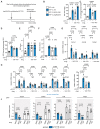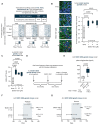This is a preprint.
A DUAL MTOR/NAD+ ACTING GEROTHERAPY
- PMID: 36711589
- PMCID: PMC9882180
- DOI: 10.1101/2023.01.16.523975
A DUAL MTOR/NAD+ ACTING GEROTHERAPY
Abstract
The geroscience hypothesis states that a therapy that prevents the underlying aging process should prevent multiple aging related diseases. The mTOR (mechanistic target of rapamycin)/insulin and NAD+ (nicotinamide adenine dinucleotide) pathways are two of the most validated aging pathways. Yet, it's largely unclear how they might talk to each other in aging. In genome-wide CRISPRa screening with a novel class of N-O-Methyl-propanamide-containing compounds we named BIOIO-1001, we identified lipid metabolism centering on SIRT3 as a point of intersection of the mTOR/insulin and NAD+ pathways. In vivo testing indicated that BIOIO-1001 reduced high fat, high sugar diet-induced metabolic derangements, inflammation, and fibrosis, each being characteristic of non-alcoholic steatohepatitis (NASH). An unbiased screen of patient datasets suggested a potential link between the anti-inflammatory and anti-fibrotic effects of BIOIO-1001 in NASH models to those in amyotrophic lateral sclerosis (ALS). Directed experiments subsequently determined that BIOIO-1001 was protective in both sporadic and familial ALS models. Both NASH and ALS have no treatments and suffer from a lack of convenient biomarkers to monitor therapeutic efficacy. A potential strength in considering BIOIO-1001 as a therapy is that the blood biomarker that it modulates, namely plasma triglycerides, can be conveniently used to screen patients for responders. More conceptually, to our knowledge BIOIO-1001 is a first therapy that fits the geroscience hypothesis by acting on multiple core aging pathways and that can alleviate multiple conditions after they have set in.
Conflict of interest statement
CONFLICT OF INTERESTS T.R.P. is the founder of BIOIO, a St. Louis-based biotech company specializing in drug target identification. BIOIO-1001 and related compounds are BIOIO assets. Conflicts of interest for T.M.M. are Ionis, licensing agreement; Consulting for Ionis, Biogen, Cytokinetics, Disarm Therapeutics, BIOIO; UCB, advisory board; Honorarium for Regeneron and Denali.
Figures



References
Publication types
Grants and funding
LinkOut - more resources
Full Text Sources
Research Materials
Miscellaneous
